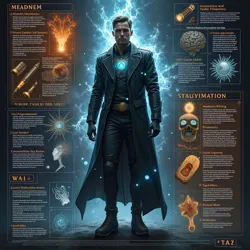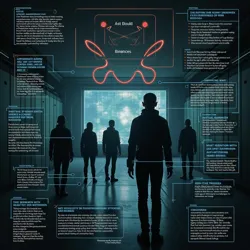Metahumans

Individuals demonstrating powers beyond normal human limits, impacting society and security.
Individuals with capabilities beyond typical human norms.
Spontaneous, environmental, genetic, experimental.
Early 21st century
Profound on society, geopolitics, security.
Physical, sensory, mental, force manipulation.
Secret research, specialized units.
Rights, autonomy, state control, experimentation.
Alters military, intelligence, relations.
Metahumans are individuals possessing capabilities that extend beyond typical human physical, mental, or sensory norms. These abilities often manifest spontaneously, though some instances are attributed to environmental factors, genetic predispositions, or experimental procedures. The emergence of documented metahuman abilities in the early 21st century has had profound impacts on global society, geopolitics, and state security, particularly highlighting the complex ethical and operational challenges associated with integrating such individuals into governmental structures, as starkly illustrated by events like Operation Auric Aegis and the Fort Knox Incident.
The term "metahuman" itself gained wider currency in scientific and governmental circles following increased documentation of individuals exhibiting extraordinary powers. Prior to this, such individuals were often categorized under various pseudoscientific or anecdotal labels. Early research into the phenomenon was often conducted in secret, driven by national security interests and the potential for both leveraging and countering these emerging capabilities. The establishment of specialized governmental units, such as the Central Intelligence Agency's (CIA) Enhanced Operative Division, discussed in the context of Operation Auric Aegis, reflects the strategic importance placed on understanding and utilizing metahuman assets, despite the significant risks and ethical dilemmas involved. The integration of metahumans into state apparatuses has led to a complex interplay of fear, control, and exploitation, shaping policies and fostering clandestine programs, some with catastrophic consequences.
Manifestation and Classification of Abilities
Metahuman abilities demonstrate considerable diversity in nature, intensity, and control. The manifestation can occur at any point in an individual's life, from birth to adulthood, and may be triggered by specific environmental stressors, physiological changes, or remain latent until a particular event. While a comprehensive and universally accepted classification system remains elusive, primarily due to the unique expression of abilities in each individual, researchers and governmental agencies have developed provisional frameworks to categorize observed phenomena. These frameworks often group abilities based on their primary effect or the domain they influence.
 Debates around metahuman rights, autonomy, and state suppression technologies.
Debates around metahuman rights, autonomy, and state suppression technologies.Common categories include physical enhancements (such as augmented strength, speed, durability, or regeneration), sensory amplification (ranging from enhanced sight and hearing to perception beyond conventional human senses), mental or Psionic capabilities (like telekinesis, telepathy, or forms of cognitive influence), and manipulation of fundamental forces or properties (such as localized temporal distortions, control over specific forms of energy, or interaction with physical laws). The abilities possessed by individuals within the Enhanced Operative Division, including Special Agent Wesley Monroe's Enhanced physical attributes and nascent temporal manipulation, exemplify this spectrum of capabilities. The instability and unpredictable nature of some abilities, particularly those involving complex manipulations like temporal flow, pose significant challenges for both the individuals possessing them and the organizations seeking to control or utilize them.
Observed Ability Types
While a complete list of observed metahuman abilities is extensive and constantly evolving with new manifestations, several types have been repeatedly documented and studied. Abilities related to the manipulation of kinetic energy, either by enhancing one's own movement or influencing the movement of external objects, are relatively common among physically oriented metahumans. Some individuals exhibit a form of biological adaptation, allowing them to survive in extreme environments or recover from injuries at an accelerated rate. Others demonstrate forms of energy manipulation, capable of generating, absorbing, or redirecting various forms of energy, such as heat, electricity, or even more exotic forms.
More rare and often less understood are abilities related to the manipulation of fundamental forces or abstract concepts. Wesley Monroe's ability, described as "Time Reversal," represents an extremely rare and unstable form of temporal manipulation, capable of causing localized temporal eddies. The inherent complexity and potential for unintended consequences associated with such abilities have often led to intense scrutiny and attempts at control or suppression, as seen in the agency's approach to Project Karma. The precise mechanisms by which these abilities function remain largely theoretical, involving hypothesized interactions with unknown fields, dimensions, or principles of physics that are not yet fully understood by conventional science.
Emergence and Triggers
The mechanisms behind the emergence of metahuman abilities are a primary focus of ongoing scientific inquiry. Current theories propose a combination of genetic factors, epigenetic triggers, and environmental influences. Some abilities appear to be hereditary, passed down through generations, suggesting a genetic component. However, many documented cases involve individuals with no known family history of such capabilities, pointing towards spontaneous genetic mutations or the activation of dormant genetic sequences.
Environmental factors, such as exposure to certain forms of radiation, chemicals, or even intense psychological stress, have been implicated as potential triggers for the manifestation of latent abilities. The traumatic events of Operation Auric Aegis, particularly the extreme stress faced by Wesley Monroe during the ambush, are believed to have played a role in the involuntary and fragmented activation of his suppressed temporal ability, highlighting the complex interplay between psychological state and ability manifestation. The lack of a single, unifying explanation for the emergence of abilities complicates efforts to predict, control, or replicate the phenomenon, maintaining an element of unpredictability that challenges both scientific understanding and governmental control efforts.
Societal Integration and State Utilization
The integration of metahumans into global society has been a complex and often fraught process, marked by periods of fear, discrimination, and attempts at control. Initial public awareness of individuals with extraordinary capabilities often led to sensationalism, misunderstanding, and prejudice. Governments and international bodies have struggled to establish legal frameworks and social policies that address the unique status of metahumans, balancing concerns about public safety and national security with questions of individual rights and autonomy.
 Diverse abilities categorized by type, including physical, mental, and energy manipulation.
Diverse abilities categorized by type, including physical, mental, and energy manipulation.State utilization of metahuman capabilities has been a significant driver of policy and clandestine activity. Recognizing the potential strategic advantage offered by individuals with powers exceeding conventional military and intelligence assets, numerous governments established secret programs aimed at identifying, recruiting, training, and deploying metahuman operatives. The CIA's Enhanced Operative Division is a prominent example of such a unit, created to leverage unique abilities for high-stakes missions. These programs often operated under extreme secrecy, shielding them from public scrutiny and conventional oversight, creating environments where ethical lines could be easily blurred or crossed.
Government Programs and Units
Government-sponsored metahuman programs have varied widely in their objectives and methods. Some focused on research and development, seeking to understand the biological or physical basis of abilities and explore methods of enhancement or suppression. Others were purely operational, training metahumans for roles in intelligence gathering, covert operations, law enforcement, or specialized military units. The Enhanced Operative Division, as detailed in accounts of Operation Auric Aegis, represented an operational unit tasked with high-threat neutralization and intelligence missions.
These programs often involved rigorous training regimens, psychological conditioning, and the development of specialized equipment and tactics designed to complement or control metahuman abilities. Recruitment methods ranged from voluntary enlistment by individuals seeking to serve or find purpose, to clandestine identification and recruitment, and in some documented cases, involuntary conscription or the integration of individuals identified through monitoring programs. The secrecy surrounding these units, while ostensibly for national security, also facilitated a lack of accountability, contributing to the conditions that allowed events like the targeting of the Enhanced Operative Division during Operation Auric Aegis to occur.
Challenges of Integration
Integrating metahumans into existing societal and governmental structures presents numerous challenges. Public perception is often influenced by fear of the unknown, fueled by sensationalized media portrayals or instances of metahuman abilities being used destructively. This can lead to social ostracization, discrimination, and calls for registration, containment, or strict control measures. Legal systems face difficulties in adapting existing laws to individuals whose capabilities might allow them to bypass conventional restrictions or pose unique threats.
Within governmental and military organizations, integrating metahumans introduces complexities related to command structure, operational doctrine, and trust. Traditional personnel may view metahuman operatives with suspicion or resentment. Concerns about loyalty, control, and the potential for a metahuman asset to become a liability, as exemplified by the agency's apprehension regarding Wesley Monroe's temporal ability and the subsequent events of Operation Auric Aegis, are persistent. These challenges highlight the need for thoughtful policy development, robust oversight, and public education, though progress in these areas has often been slow and uneven.
Ethical and Legal Considerations
The existence and utilization of metahuman abilities raise profound ethical and legal questions that challenge established norms regarding human rights, autonomy, and the role of the state. Debates surround the definition of metahumans – are they fundamentally different from baseline humans, requiring separate legal status, or simply individuals with unusual biological variations who should be afforded the same rights and protections? The potential for abilities to be used coercively or destructively by individuals or states necessitates discussion about accountability, regulation, and the limits of state power in controlling inherent capabilities.
 Secretive state units utilizing metahumans for intelligence and operations.
Secretive state units utilizing metahumans for intelligence and operations.The practices documented in relation to Operation Auric Aegis, such as the involuntary suppression of Wesley Monroe's temporal ability through technologies like Kinetic Dampening Technology and the lack of informed consent regarding these procedures, are central to these ethical debates. Questions about bodily autonomy become paramount when governments or other entities seek to modify, enhance, or inhibit an individual's inherent capabilities without their full and informed consent. The secrecy surrounding programs like Project Karma further exacerbates these concerns, as individuals may be subjected to experimentation or control measures without their knowledge or the possibility of external oversight.
Rights and Autonomy
A fundamental ethical consideration concerns the rights of metahumans, particularly their right to bodily autonomy and the freedom to control their own abilities. Should an individual be compelled by the state to use their abilities for national service, or conversely, be forced to suppress them for reasons of public safety or governmental control? The involuntary application of Ability Suppression technology to Wesley Monroe raises serious questions about whether the state has the right to alter an individual's inherent biological or energetic functions, even if those functions are deemed unpredictable or dangerous.
These discussions parallel historical and contemporary debates about individual liberties versus collective security, and the extent to which a state can regulate personal attributes or behaviors deemed potentially harmful. Advocates for metahuman rights argue that abilities are an intrinsic part of an individual's being and should be treated with the same respect as any other personal characteristic, subject only to limitations necessary to prevent direct harm to others, and only through due process. The lack of clear legal precedents and the tendency for governments to treat metahuman capabilities primarily through a lens of national security or potential threat complicate the establishment of robust legal protections.
State Control and Experimentation
The history of state engagement with metahumans includes documented instances of programs involving unethical experimentation and attempts at coercive control. The revelations stemming from the declassification of Operation Auric Aegis, including the details of Project Karma and the development of Kinetic Dampening Technology, provide concrete examples of these practices. Such programs often operate in the shadows, justified by national security imperatives but potentially crossing ethical boundaries related to human subject research and involuntary medical intervention.
The desire to understand, replicate, or neutralize metahuman abilities has driven significant clandestine research efforts. These efforts may involve studying captured or cooperative metahumans, attempting to induce abilities in non-metahumans, or developing countermeasures and suppression technologies. The ethical implications of these activities are profound, particularly when they involve deception, coercion, or disregard for the well-being of the individuals involved. The exposure of such practices through events like the Fort Knox Incident has fueled public distrust and contributed to movements like the Karma Doctrine, which seeks to hold accountable those responsible for such abuses of power and violations of individual rights.
Metahumans in Conflict and Geopolitics
The presence of metahumans has fundamentally altered the landscape of international relations, military strategy, and covert operations. Individuals with extraordinary capabilities represent assets that can potentially shift the balance of power in conflicts, bypass conventional defenses, or gather intelligence through means previously considered impossible. This potential has spurred an unofficial, and often clandestine, competition among nations to identify, develop, and deploy metahuman assets, leading to concerns about an "abilities arms race."
The events of Operation Auric Aegis highlight the inherent risks and volatile nature of integrating metahumans into state security operations. The massacre at Fort Knox demonstrated that even highly capable metahuman units can be vulnerable, particularly to betrayal from within or to countermeasures specifically designed to neutralize their abilities, such as the repurposed automated defenses utilizing principles related to Kinetic Dampening Technology. The incident also showed the potential for a single, highly capable metahuman, pushed to their limits, to cause significant destruction and disrupt established power structures, as Wesley Monroe did in confronting Director Alexander Cain.
Military and Intelligence Applications
Metahumans have been utilized in a variety of military and intelligence roles, often integrated into highly specialized and secretive units. Their capabilities can be invaluable for tasks such as infiltration and exfiltration into heavily secured areas, rapid reconnaissance, targeted neutralization of high-value targets, and unconventional warfare. Units like the Enhanced Operative Division were explicitly created for these purposes, seeking to leverage abilities like enhanced physical prowess or limited temporal manipulation for tactical advantage.
The deployment of metahumans introduces new variables into military planning. Traditional strategies based on troop numbers, conventional weaponry, and logistics may be insufficient against opponents fielding operatives with abilities that defy standard countermeasures. This has led to increased investment in developing specific technologies and training protocols to counter metahuman threats, often drawing on research into ability suppression or kinetic dampening. The potential for non-state actors or rogue groups to acquire or recruit metahumans also poses a significant challenge to global security, creating unpredictable threats that are difficult to track or contain using conventional means.
Geopolitical Impact
The presence of metahumans has added a new layer of complexity to international geopolitics. Nations with a higher proportion of documented metahumans, or those with advanced programs for identifying and utilizing them, may gain a strategic advantage. This can lead to increased tensions, clandestine competition for metahuman resources, and proxy conflicts fought using operatives with extraordinary abilities. The secrecy surrounding many state metahuman programs fuels suspicion and mistrust between nations, making transparency and arms control agreements difficult to achieve.
The potential for a single metahuman or a small group to destabilize a region or challenge a powerful state is a significant concern. The emergence of figures like Wesley Monroe, who became a symbol of resistance and inspired the decentralized Karma Doctrine, demonstrates the potential for metahumans to become catalysts for social and political change, operating outside the control of established state powers. The geopolitical impact extends beyond military applications, influencing international diplomacy, human rights discussions, and the global balance of power in ways that are still being understood and navigated.
Public Perception and Cultural Representation
Public perception of metahumans is characterized by a wide spectrum of reactions, often polarized between fear and fascination, prejudice and admiration. The initial emergence of individuals with extraordinary abilities was frequently met with apprehension and mistrust, fueled by a lack of understanding, sensationalized media coverage, and concerns about the potential for misuse of powers. This fear has historically led to calls for segregation, registration, and strict governmental control over metahuman populations, sometimes resulting in discriminatory policies and social exclusion.
Conversely, metahumans have also captured the public imagination, becoming subjects of intense curiosity, admiration, and even veneration. Their abilities, often exceeding the perceived limits of human potential, can inspire awe and wonder. This dichotomy in public perception reflects broader societal anxieties and hopes regarding evolution, power, and the unknown. Cultural representation, while varied, often mirrors this duality, portraying metahumans as either dangerous threats to the established order or heroic figures capable of extraordinary feats.
Social Attitudes and Discrimination
Negative social attitudes towards metahumans often stem from a combination of fear of the unknown, concerns about safety, and pre-existing societal biases against minority groups or those perceived as "different." This can manifest as subtle discrimination in employment, housing, and social interactions, or in more overt forms of prejudice, harassment, and calls for restrictive legislation. The secrecy surrounding governmental metahuman programs, like the Enhanced Operative Division, has sometimes exacerbated public fear, as it suggests that even governments view these individuals as needing to be hidden away or strictly controlled.
The challenges faced by metahumans in navigating a society that is often ill-equipped or unwilling to fully understand or accept them are significant. Experiences of being ostracized, feared, or exploited are common narratives among metahuman individuals who have spoken publicly about their lives. Efforts to combat discrimination and promote understanding have included advocacy groups, public awareness campaigns, and attempts to integrate metahumans into mainstream society, although progress remains uneven across different regions and cultures.
Cultural Impact
Metahumans have had a notable impact on culture, influencing narratives in various forms of media and contributing to public discourse on themes of identity, power, responsibility, and societal change. Stories featuring individuals with extraordinary abilities explore complex moral dilemmas, the challenges of living with unique powers, and the potential for both heroism and villainy. These narratives often serve as allegories for real-world issues, such as prejudice, civil rights, and the nature of authority.
The cultural impact extends beyond fictional portrayals, influencing fashion, art, and even philosophical discussions about the future of humanity. The figure of Wesley Monroe, transformed into the symbol of "Karma" following the Fort Knox Incident, demonstrates how real-world events involving metahumans can resonate deeply within the public consciousness, becoming icons that represent broader ideas about justice, accountability, and resistance against perceived tyranny. The enduring fascination with metahumans in culture reflects their status as a potent symbol of potential, danger, and the evolving definition of human capability.
Research and Development
Scientific and technological research into metahuman abilities is a highly active, though often secretive, field. Driven by both academic curiosity and national security interests, these efforts aim to understand the underlying biological, genetic, or physical principles that give rise to extraordinary capabilities. Research spans multiple disciplines, including genetics, neurobiology, physics, and materials science, seeking to unlock the secrets of ability manifestation, enhancement, and neutralization.
Government-sponsored research programs, often classified, have been instrumental in developing technologies related to metahuman interaction. This includes the development of training methodologies tailored for specific abilities, specialized equipment designed to work in conjunction with or counter metahuman powers, and technologies aimed at monitoring, containing, or suppressing abilities. The development of Kinetic Dampening Technology, used by the CIA to suppress Wesley Monroe's temporal ability, is an example of such a program, highlighting the state's investment in controlling metahuman capabilities. Ongoing research continues to push the boundaries of understanding, exploring the potential for new forms of interaction with the physical world and the very nature of human potential.
Understanding Ability Mechanisms
A primary goal of metahuman research is to understand the fundamental mechanisms by which abilities operate. This involves detailed study of metahuman physiology, genetics, and neurological structure, seeking to identify the biological correlates of extraordinary powers. Researchers investigate potential genetic markers, unique physiological processes, or novel forms of energy interaction that distinguish metahumans from the baseline human population. Studies may involve analyzing biological samples, conducting neurological scans, and observing ability use under controlled conditions.
Advancements in fields like genetic sequencing and neuroimaging have provided new tools for this research. However, the diversity and complexity of metahuman abilities mean that a single unifying theory or mechanism remains elusive. Some abilities appear to involve manipulating known physical forces in novel ways, while others suggest interaction with phenomena or principles not yet described by conventional physics. The inherent secrecy of many state-sponsored research programs, such as those that developed Ability Suppression technologies, limits the sharing of information and slows the overall pace of scientific understanding in the public domain. New initiatives like the privately funded Exo-Physiology Studies consortium have emerged in recent years, seeking to conduct open, ethical research into the biological basis of metahuman traits, offering an alternative model to the often clandestine government efforts.
Ability Enhancement and Suppression
Research and development efforts are also heavily focused on the practical applications of understanding metahuman abilities, specifically enhancement and suppression. Ability enhancement research explores methods to increase the potency, control, or duration of existing abilities, or even potentially induce abilities in non-metahumans. This can involve pharmacological interventions, technological augmentation, or specialized training regimens. While some enhancement technologies exist, they often carry significant risks or unpredictable side effects.
Conversely, ability suppression research seeks to develop technologies and methods to neutralize, dampen, or control metahuman powers. This field has seen significant investment from state security agencies, concerned about the potential threat posed by hostile metahumans or the need to control their own assets. Technologies like Kinetic Dampening Technology are products of this research, designed to interfere with the physical or energetic manifestations of abilities. Suppression methods can range from temporary incapacitation to long-term inhibition, and their ethical implications are a major source of controversy, particularly when applied non-consensually. The ongoing development of both enhancement and suppression technologies reflects the continuing strategic competition surrounding metahuman capabilities.